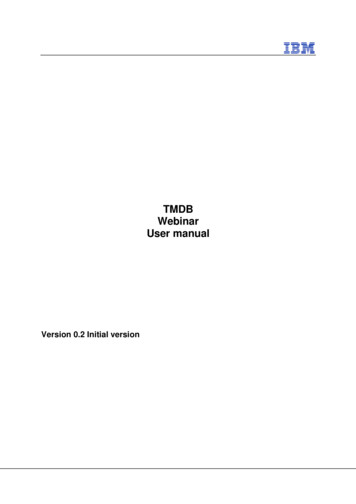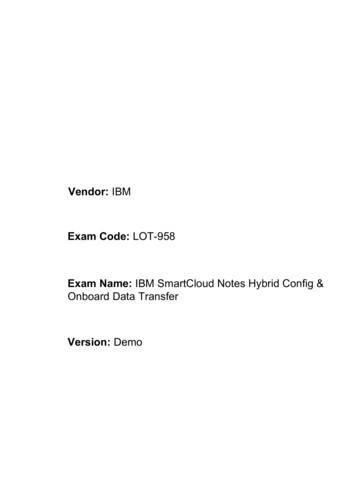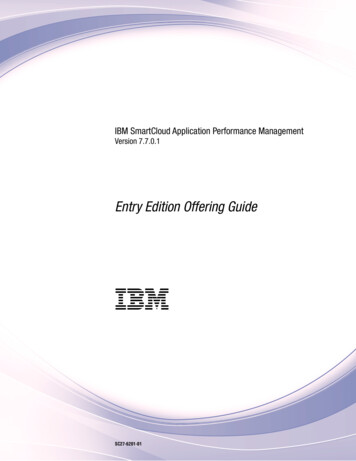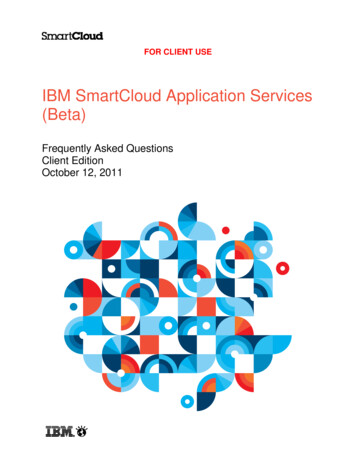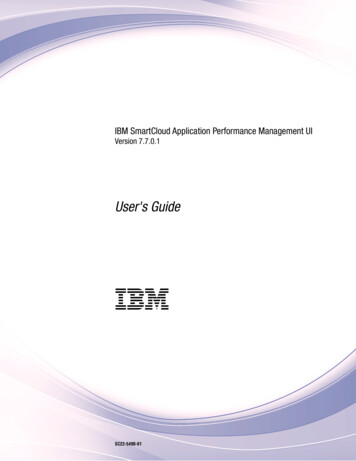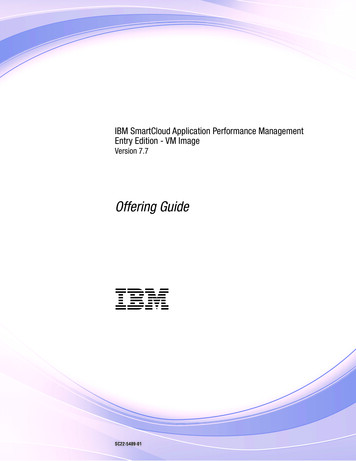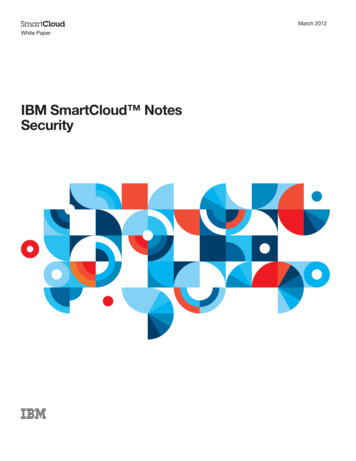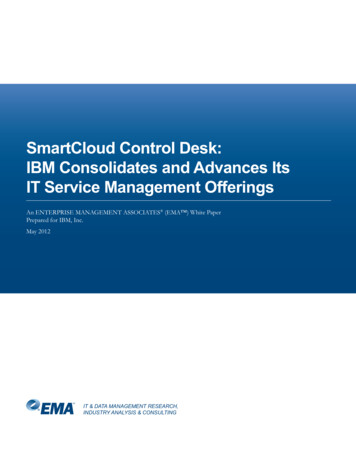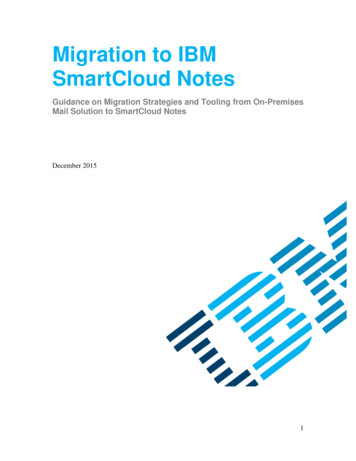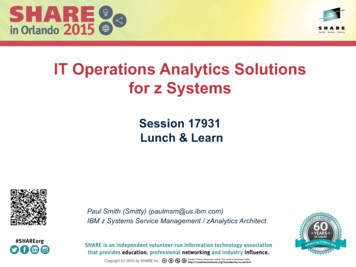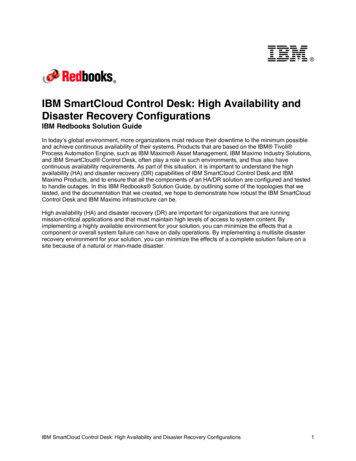
Transcription
IBM SmartCloud Control Desk: High Availability andDisaster Recovery ConfigurationsIBM Redbooks Solution GuideIn today’s global environment, more organizations must reduce their downtime to the minimum possibleand achieve continuous availability of their systems. Products that are based on the IBM Tivoli Process Automation Engine, such as IBM Maximo Asset Management, IBM Maximo Industry Solutions,and IBM SmartCloud Control Desk, often play a role in such environments, and thus also havecontinuous availability requirements. As part of this situation, it is important to understand the highavailability (HA) and disaster recovery (DR) capabilities of IBM SmartCloud Control Desk and IBMMaximo Products, and to ensure that all the components of an HA/DR solution are configured and testedto handle outages. In this IBM Redbooks Solution Guide, by outlining some of the topologies that wetested, and the documentation that we created, we hope to demonstrate how robust the IBM SmartCloudControl Desk and IBM Maximo infrastructure can be.High availability (HA) and disaster recovery (DR) are important for organizations that are runningmission-critical applications and that must maintain high levels of access to system content. Byimplementing a highly available environment for your solution, you can minimize the effects that acomponent or overall system failure can have on daily operations. By implementing a multisite disasterrecovery environment for your solution, you can minimize the effects of a complete solution failure on asite because of a natural or man-made disaster.IBM SmartCloud Control Desk: High Availability and Disaster Recovery Configurations1
Figure 1 shows a local high availability topology example.Figure 1. Local high availability topology exampleThis IBM Redbooks Solution Guide provides an overview of the configuration possibilities for a highavailability and disaster recovery solution with IBM Maximo and SmartCloud Control Desk. Moreinformation can be found in High Availability and Disaster Recovery Configurations for IBM SmartCloudControl Desk and IBM Maximo Products, SG24-8109.Did you know?The availability of any application is measured by its overall uptime. If the users experience errors,timeouts because of the system load, or the application cannot connect to the database, then theapplication is not considered highly available. Network outages, hardware failure, operating system orother software-related errors, and power interruptions are examples of failure that can lead tounavailability to the users. If there are such failures, the highly available solution must be able to performthe following tasks: Shield the application from the failure without appreciable performance degradation.Fail over to another server on the cluster.Recover from the failure to return the application to normal operations.In addition, in a highly available application, the impact of maintenance activities on the availability mustbe minimized.IBM SmartCloud Control Desk: High Availability and Disaster Recovery Configurations2
Business valueThe most common business drivers for increased availability of a particular solution are cost of downtime,service-level agreements (SLAs), and user satisfaction. Although these drivers are the most commonones, other business drivers might exist: Cost of system outageCritical applications and processes can be impacted during system downtime, which can lead topotential loss of revenue as operations might be at a standstill. The benefits of creating systemredundancy often outweigh the financial impact of an outage. Maintaining a high availability anddisaster recovery solution can be compared with having a good insurance policy. Service-level agreementSmartCloud Control Desk is used to manage enterprise assets, IT environments, and availability ofsystems. These tasks are commonly referenced in SLAs. Therefore, contractual obligations canmandate a certain level of system availability to meet SLAs. User satisfactionFrequent and unexpected outages during system usage can directly impact user satisfaction. Userswho rely on Maximo and SmartCloud Control Desk for daily operations might lose confidence in thesolution if their productivity is affected.Solution overviewThe solution relies on the high availability of the underlying components, such as web server, applicationserver, database, LDAP server, and the Tivoli Process Automation Engine. A cluster manager can beused to monitor and automate system failover. You can configure the components of your solutionenvironment for high availability in various ways. Different high availability configurations handle failoverdifferently. For this reason, it is important to choose the correct configuration to suit the needs for yourorganization.High Availability and Disaster Recovery Configurations for IBM SmartCloud Control Desk and IBMMaximo Products, SG24-8109 explains how to design and configure three potential topologies: Local high availability topologyLocal high availability implies redundancy and failover of all the essential components that arecontained within a single site. Although local high availability does not provide the disaster protectionof a multisite topology, it does provide protection from system, process, and hardware failures. Bydefining and eliminating all single points of failure, you can strengthen your IBM SmartCloud ControlDesk or Maximo infrastructure and decrease system downtime.Local high availability is also a great place to start when you try to achieve a full disaster recoveryplan. For example, when multiple sites are introduced, having local high availability on these sites canprevent the need to execute a full disaster recovery procedure when there is just a component failureon the overall solution. Active-passive disaster recoveryActive-passive disaster recovery implies complete site replication to an alternative location so thatservices can be restored when the primary site goes down. The second site is not processing usertransactions and is sitting idle until a failover is required. This topology can be thought of as a type ofinsurance policy for the IBM SmartCloud Control Desk and Maximo infrastructure.IBM SmartCloud Control Desk: High Availability and Disaster Recovery Configurations3
An active-passive site configuration can provide a company with a contingency plan when anunexpected failure occurs. File system, database, and backup/restore procedures can beimplemented to keep the passive site synchronized with the primary. The technologies that are useddepend on the distance, budget, and synchronization state that is required by the organization.Having a reliable, high-speed network infrastructure and link between the sites is one of the mostimportant elements in the plan. Hybrid-active disaster recoveryFor some organizations, having a completely passive site means that there are resources that are notused unless a disaster recovery is needed, so there is a desire to use this infrastructure as much aspossible. The ability to bring certain services online and process user requests is a possibility in amultisite disaster recovery topology. You should consider many factors before you choose this type oftopology.IBM SmartCloud Control Desk and Maximo do not support a completely active-active environmentwhere there are primary databases that are located at each site. For this reason, the application inboth sites needs to point to the same database server. This active database can be replicated byusing IBM DB2 HADR or other database replication technologies to Site B. If Site A fails, theapplications on Site B need to be reconfigured to point to the database locally.Figure 2 shows a hybrid-active topology with a remote database connection.Figure 2. Example hybrid-active topology showing a remote database connectionIBM SmartCloud Control Desk: High Availability and Disaster Recovery Configurations4
Solution architectureAs Maximo and SmartCloud Control Desk are applications that are deployed to middleware, the overallavailability of the system depends on the configuration of these middleware components. This documentbriefly describes some of the features that are available from the middleware. More specific configurationdetails can be found in High Availability and Disaster Recovery Configurations for IBM SmartCloudControl Desk and IBM Maximo Products, SG24-8109.Here are the middleware components that are involved in the infrastructure: DatabaseThe database stores all the data that is used by the application and is a critical component for theapplication. Database technologies that can be implemented include DB2 HA Feature with SharedDisk, DB2 HADR log shipping, and DB2 pureScale active clustering. With DB2 HADR, the standbydatabase can be opened in read-only mode and used as a reporting replica, as shown in Figure 3.Oracle Real Application Clusters (RAC) and Active DataGuard are also supported.Figure 3. DB2 HADR configuration with a read-only replica Application serverThe application server hosts the application and connects to the database to deliver the UI and all itsfeatures to users. The most common method for HA and DR for the application server is using IBMWebSphere Application Server clustering across multiple nodes. With clustering, you can havemultiple Java virtual machines (JVMs) on each node, but it is important to spread across multiplenodes to eliminate single points of failure. Clustering your application server gives you the benefit ofhigh availability combined with increased performance and scalability.IBM SmartCloud Control Desk: High Availability and Disaster Recovery Configurations5
Web serverThe web server can be used as a single access point for users and can also distribute users acrossmany application server Java virtual machines (JVMs). It is important to have at least one other webserver node that can take over if the primary fails. Often, organizations eliminate the web servercomponent and replace it with a load balancer (or use load balancers with web servers). If so, it isimportant that the load balancer itself is not a single point of failure. User directory (LDAP)If your organization uses LDAP security for the Maximo or SmartCloud Control Desk, this LDAPcomponent must also be made highly available. Maximo and SmartCloud Control Desk support usingTivoli Directory Server and Microsoft Active Directory as suitable LDAP servers. Each product has itsown user replication techniques and should be implemented as a prerequisite to the topologyconfiguration. Cluster managerA cluster manager is an optional component, but can be introduced in to the topology to help monitor,detect failure of, and automatically fail over applications, processes, IP addresses, and service toother nodes. Cluster managers can greatly decrease the impact of a failure, as it automatically takesaction when a failure occurs. The preferred cluster manager solution in this configuration is IBM TivoliSystem Automation for Multiplatforms (SA MP).Eliminating all single points of failure by enabling high availability and disaster recovery for each of thesecomponents help you meet your organization's need for a continuously available application.Usage scenariosThe high availability and disaster recovery solutions are often implemented when the costs of systemdowntime exceed the cost of adding redundancy to the infrastructure. Here are some example scenarios: Scenario 1 – Local high availabilityAn organization determines that they require redundancy and failover capabilities to make theirSmartCloud Control Desk application available to meet specific service operation levels. Thisparticular organization does not have a second site or the capital to introduce a second site.Implementing a local high availability topology can allow for system and process failure without thecosts that are associated with a second site Scenario 2 – Multisite disaster recoveryAn organization has been running a local high availability solution for some time now and hasdetermined that they require a second site for protection from complete site failure or a disaster. Thisorganization is in a region that is particularly vulnerable to severe weather conditions. By addinganother site to the topology, the application can be restored if a site becomes inactive because of adisaster. It is recommended that the second site be far enough away that the same severe weatherconditions do not affect both sites.IBM SmartCloud Control Desk: High Availability and Disaster Recovery Configurations6
IntegrationMaximo and SmartCloud Control Desk both can integrate with external systems through the IntegrationFramework. Using the WebSphere Application Server built-in Service Integration Bus (SIB), a system canprocess inbound and outbound transactions through message queues. This SIB configuration can beduplicated from one site to another and combined with database and file system replication to allowtransactions to fail over from one site to the other during a disaster recovery. Without the ability to fail overtransactions, any messages that were in the queues are stuck until the system is brought back online.This configuration is shown in Figure 4.Figure 4. Service Integration Bus Active/Passive configurationHigh Availability and Disaster Recovery Configurations for IBM SmartCloud Control Desk and IBMMaximo Products, SG24-8109 goes into further about on how to configure this configuration. It alsotouches on using IBM WebSphere MQ versus the SIB.Supported platformsThe supported middleware versions and platforms for this solution depends on the version of Maximo orSmartCloud Control Desk that is being implemented. Information about supported platforms for theseproducts can be found in the Product Configuration Matrix athttp://www.ibm.com/support/docview.wss?uid swg27014419.Ordering informationThis product is available only through IBM Passport Advantage . It is not available as a shrink-wrappedproduct. Detailed ordering information is available at the IBM Offering Information website (see the"Related information" section).Related informationFor more information, see the following documents: IBM Redbooks publication: High Availability and Disaster Recovery Configurations for IBMSmartCloud Control Desk and IBM Maximo Products, 48109.html IBM Maximo Asset Management product -asset-mgmt/IBM SmartCloud Control Desk: High Availability and Disaster Recovery Configurations7
IBM SmartCloud Control Desk product oudcontroldesk/ IBM Offering Information page (announcement letters and sales equest locale enOn this page, enter IBM SmartCloud Control Desk, select the information type, and then clickSearch. On the next page, narrow your search results by geography and language.IBM SmartCloud Control Desk: High Availability and Disaster Recovery Configurations8
NoticesThis information was developed for products and services offered in the U.S.A.IBM may not offer the products, services, or features discussed in this document in other countries. Consult your localIBM representative for information on the products and services currently available in your area. Any reference to anIBM product, program, or service is not intended to state or imply that only that IBM product, program, or service maybe used. Any functionally equivalent product, program, or service that does not infringe any IBM intellectual propertyright may be used instead. However, it is the user's responsibility to evaluate and verify the operation of any non-IBMproduct, program, or service. IBM may have patents or pending patent applications covering subject matter describedin this document. The furnishing of this document does not give you any license to these patents. You can sendlicense inquiries, in writing, to:IBM Director of Licensing, IBM Corporation, North Castle Drive, Armonk, NY 10504-1785 U.S.A.The following paragraph does not apply to the United Kingdom or any other country where such provisions areinconsistent with local law : INTERNATIONAL BUSINESS MACHINES CORPORATION PROVIDES THISPUBLICATION "AS IS" WITHOUT WARRANTY OF ANY KIND, EITHER EXPRESS OR IMPLIED, INCLUDING, BUTNOT LIMITED TO, THE IMPLIED WARRANTIES OF NON-INFRINGEMENT, MERCHANTABILITY OR FITNESSFOR A PARTICULAR PURPOSE. Some states do not allow disclaimer of express or implied warranties in certaintransactions, therefore, this statement may not apply to you. This information could include technical inaccuracies ortypographical errors. Changes are periodically made to the information herein; these changes will be incorporated innew editions of the publication. IBM may make improvements and/or changes in the product(s) and/or the program(s)described in this publication at any time without notice.Any references in this information to non-IBM Web sites are provided for convenience only and do not in any mannerserve as an endorsement of those Web sites. The materials at those Web sites are not part of the materials for thisIBM product and use of those Web sites is at your own risk.IBM may use or distribute any of the information yousupply in any way it believes appropriate without incurring any obligation to you. Information concerning non-IBMproducts was obtained from the suppliers of those products, their published announcements or other publicly availablesources. IBM has not tested those products and cannot confirm the accuracy of performance, compatibility or anyother claims related to non-IBM products. Questions on the capabilities of non-IBM products should be addressed tothe suppliers of those products. This information contains examples of data and reports used in daily businessoperations. To illustrate them as completely as possible, the examples include the names of individuals, companies,brands, and products. All of these names are fictitious and any similarity to the names and addresses used by anactual business enterprise is entirely coincidental.Any performance data contained herein was determined in a controlled environment. Therefore, the results obtainedin other operating environments may vary significantly. Some measurements may have been made ondevelopment-level systems and there is no guarantee that these measurements will be the same on generallyavailable systems. Furthermore, some measurement may have been estimated through extrapolation. Actual resultsmay vary. Users of this document should verify the applicable data for their specific environment.COPYRIGHT LICENSE:This information contains sample application programs in source language, which illustrate programming techniqueson various operating platforms. You may copy, modify, and distribute these sample programs in any form withoutpayment to IBM, for the purposes of developing, using, marketing or distributing application programs conforming tothe application programming interface for the operating platform for which the sample programs are written. Theseexamples have not been thoroughly tested under all conditions. IBM, therefore, cannot guarantee or imply reliability,serviceability, or function of these programs. Copyright International Business Machines Corporation 2013. All rights reserved .Note to U.S. Government Users Restricted Rights -- Use, duplication or disclosure restricted byGSA ADP Schedule Contract with IBM Corp.IBM SmartCloud Control Desk: High Availability and Disaster Recovery Configurations9
This document was created or updated on May 6, 2013.Send us your comments in one of the following ways:Use the online Contact us review form found at:ibm.com/redbooks Send your comments in an e-mail to:redbook@us.ibm.com Mail your comments to:IBM Corporation, International Technical Support OrganizationDept. HYTD Mail Station P0992455 South RoadPoughkeepsie, NY 12601-5400 U.S.A. This document is available online at l .TrademarksIBM, the IBM logo, and ibm.com are trademarks or registered trademarks of International BusinessMachines Corporation in the United States, other countries, or both. These and other IBM trademarkedterms are marked on their first occurrence in this information with the appropriate symbol ( or ),indicating US registered or common law trademarks owned by IBM at the time this information waspublished. Such trademarks may also be registered or common law trademarks in other countries. Acurrent list of IBM trademarks is available on the Web at http://www.ibm.com/legal/copytrade.shtml.The following terms are trademarks of the International Business Machines Corporation in the UnitedStates, other countries, or both:DB2 IBM IBM SmartCloud Maximo Passport Advantage pureScale Redbooks Redbooks (logo) Tivoli WebSphere The following terms are trademarks of other companies:Linux is a trademark of Linus Torvalds in the United States, other countries, or both.Microsoft, and the Windows logo are trademarks of Microsoft Corporation in the United States, othercountries, or both.Java, and all Java-based trademarks and logos are trademarks or registered trademarks of Oracle and/orits affiliates.Other company, product, or service names may be trademarks or service marks of others.IBM SmartCloud Control Desk: High Availability and Disaster Recovery Configurations10
This IBM Redbooks Solution Guide provides an overview of the configuration possibilities for a high availability and disaster recovery solution with IBM Maximo and SmartCloud Control Desk. More information can be found in High Availability and Disaster Recovery Configurations for IBM SmartCloud Control Desk and IBM Maximo Products, SG24-8109.
